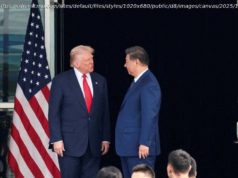Just about everybody assumes that China will overtake the U. S. as the world’s indispensable economy. One factor, however, could slow its seemingly relentless march and cast doubt on China’s prospects for becoming an advanced economy: faltering productivity.
Just about everybody assumes that China will overtake the U. S. as the world’s indispensable economy. One factor, however, could slow its seemingly relentless march and cast doubt on China’s prospects for becoming an advanced economy: faltering productivity.
Sure, China is advancing daily in wealth, technology and expertise. But nothing is inevitable in economics. As costs rise and the labor force shrinks due to Beijing’s decades-long “one-child” policy, China will need to squeeze a lot more out of each remaining worker to keep incomes growing. If not, China could succumb to a sluggish trajectory that threatens both its future and that of the entire global economy.
Despite China’s reputation as a paragon of authoritarian efficiency, the country isn’t immune to the global trend of dwindling productivity gains. The Conference Board, using adjusted economic growth estimates, figures that Chinese labor productivity rose 3.7 percent in 2015, a precipitous plunge from an average of 8.1 percent annually between 2007 and 2013. (Official Chinese statistics also show productivity growth falling off, although settling at higher rates.)
Of course, even that reduced clip looks drool-worthy to policymakers elsewhere. Labor productivity inched upwards by a mere 0.7 percent in the U. S. and 0.6 percent in the euro zone in 2015. But the smaller increases in China are a big problem, because it has so much catching up to do. Chinese workers are miserably unproductive compared to their U. S. counterparts. The Conference Board calculates that in 2015 each employed worker in China generated only 19 percent of the amount of GDP an American worker did. That’s not a whole lot better than Indian workers, who created 13 percent.
China, like other economies in Asia, is facing the consequences of its past success. The region’s economies achieved eye-popping growth rates by tossing their poor and primarily agrarian workers into industry and global supply chains. That unleashed a torrent of productivity gains, as peasant farmers started making everything from teddy bears to iPhones.
In other words, China propelled its rapid development by shifting underutilized labor and capital into a modern capitalist economy. (That’s why Paul Krugman once argued that there was nothing particularly miraculous about the Asian “miracle.”) Inevitably, though, such low-hanging, productivity-enhancing fruit gets picked as the economy advances. Then the bang you get for every buck of new inputs starts to taper off.
That’s the challenge China now faces. As Harry X. Wu, a development expert at Japan’s Hitotsubashi University, has put it: “China needs to focus on getting more out of its available resources, rather than relying on rapid capital accumulation.”
The problem is that China isn’ t doing particularly well on that front. Financial resources continue to be wasted on inefficient, often state-owned enterprises in bloated industries — all those “zombie” companies in sectors like steel, coal and cement. This steals critical resources away from more productive firms. As economists at Rabobank warned in a March report, the system works against the « favorable entrepreneurial environment and Schumpeterian creative destruction” that is essential to improve productivity.
Even China’s attempts to foster new, high-tech industries and entrepreneurs may be somewhat counterproductive. By doling out large subsidies in targeted sectors, such as electric vehicles, as well as easy-to-obtain handouts to start-ups, the state, again, is messing around with markets and not allowing truly productive companies to rise to the top. It’s telling that China’s productivity gains have slumped even as its campaign for innovation and “mass entrepreneurship” has intensified.
The downside of these policies shows itself in another measure called total factor productivity, or TFP, which is the amount of output that is not generated by inputs alone. By the Conference Board’s reckoning, China’s TFP actually shrank in 2015, which means greater growth of capital and labor are necessary to produce the same amount of goods and services. In that sense, China is losing ground both to the U. S., where TFP grew 0.1 percent in 2015, and other emerging economies, such as India, which witnessed a 1.2 percent advance.
For China, the consequences could be severe. The Rabobank economists fret that feeble productivity gains might ensnare China in the dreaded middle-income trap — a disheartening deceleration of growth once incomes reach a certain substantial, but not advanced, level. And since China’s contributions have loomed large in global economic growth, a slowdown would hurt everyone from iron-ore miners to coffee tillers to French-fry fryers.
To escape such a fate, Rabobank’s economists recommend a slate of productivity-enhancing policies, including strengthening human capital by improving education and tailoring the regulatory environment to better support innovation by, for instance, bolstering intellectual property protections. Chinese companies need to spend more on research and development, too. China still trails rivals like South Korea and Japan in the amount invested in R&D, relative to national output.
Of course, what China really requires is the sort of free-market reform that the current leaders in Beijing have been so reluctant to implement. The state needs to allow market forces to allocate money and talent to the country’s most competitive and productive industries and companies.
For the U. S., there is the glimmer of a silver lining. Unless China can lift its productivity, any edge it had over more advanced economies will wither. Boston Consulting Group estimates that when the superior productivity of American workers is taken into account, the costs of manufacturing in China and the U.






